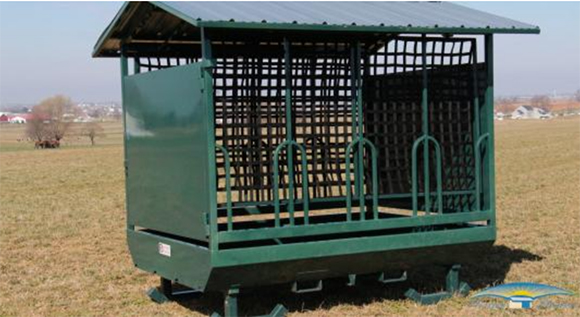Horizon Structures Addresses The Need For Horse Hay Feeders
By Nikki Alvin-Smith
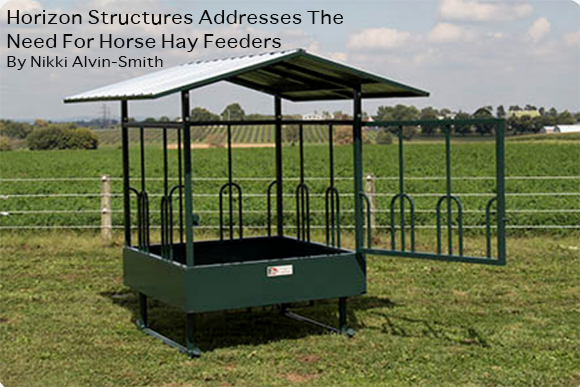
Leading modular horse barn company Horizon Structures LLC, has recently added outdoor horse hay feeders to their line up of product offerings. You probably know Horizon Structures well as providers of shelter for ‘all creatures great and small’, and this new product range steps outside of their usual barn door. We asked Mark Zook, Project Manager at Horizon Structures, why equine hay feeders have been added to their product line:
“We have had a lot of requests over the years for hay feeders and now we have partnered with a shop that builds high quality horse feeders for very good prices. We believe that the more we can serve our customers the happier they will be, hay feeders and horse barns go hand in hand. We want to provide them for our customers so now they can get their barn and feeder all in one shipment. If the customers are local we can ship them fully assembled. If they are located in farther locations we can ship them in a kit for that is very easy to put together and it saves a lot on shipping since they are in kit form.”
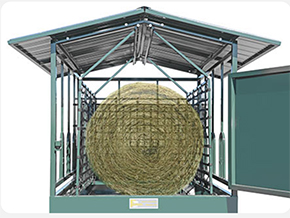 Feeders can also be bought separately from a barn, kennel, coop or run-in shed purchase. Horizon Structures is offering a range of four styles, to address both small and large square bales as well as the increasingly common large round bales of hay.
Feeders can also be bought separately from a barn, kennel, coop or run-in shed purchase. Horizon Structures is offering a range of four styles, to address both small and large square bales as well as the increasingly common large round bales of hay.
Should you use a hay feeder and if so, which style should you buy? Here are a few tips based on proven scientific research and a few caveats about use and design based on my personal experiences.
Hay feeders have been around for eons. Hay is a valuable forage ingredient in the equine diet both in terms of nutrition during colder months and cost to make or purchase. No horse owner wants to see it wasted. Before the advent of the baler, barns were often constructed with troughs or wall feeders in the stalls as containment for the long scythe cut hay that was brought in from the fields on hay wains. When outside, cattle and horses routinely shared pastures and troughs for feeding were made from roughly hewn lumber often with wooden slats to minimize hay wastage.
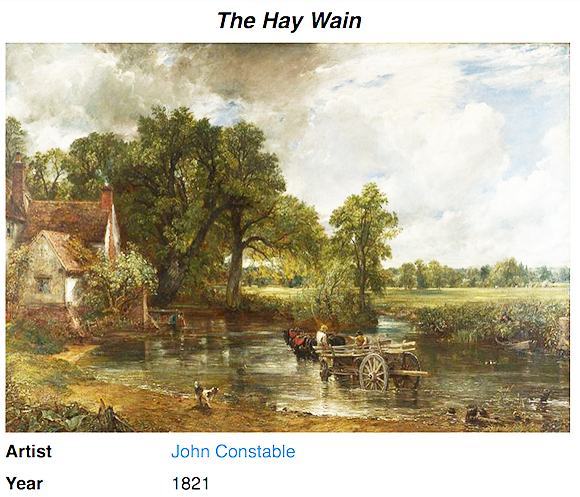
During my youth growing up in England, most brick horse barns utilized metal feeders in the stalls. In more contemporary buildings that were built without horse hay feeders, we used haynets as a means of keeping the expensive hay commodity off the ground. Today slow hay feeder bags have become popular, as a means of controlling the pace that the horse munches through its hay ration. Use of a hay feeder outside provides similar benefits.
Research from the University of Minnesota, authored by Amanda Grev, Emily Glunk, Marcia Hathaway, William Lazarus, and Krishona Martinson, proved that outdoor feeders can indeed save the horse owner considerable money on hay and slow down the ingestion pace of hay rations.
Their research objective was to analyze the following: “Hay is commonly fed to horses and is usually the largest and most expensive dietary component for adult horses. Hay waste can occur during both storage and feeding, and can add up to > 40%, depending on forage type, storage method, environment, and storage length. It is common knowledge that many horses are fed small square-bales in outdoor paddocks; however, no research exists to characterize hay waste of small square-bales fed in outdoor paddocks.”
The results of the study conducted in October 2016, are showcased in this table.
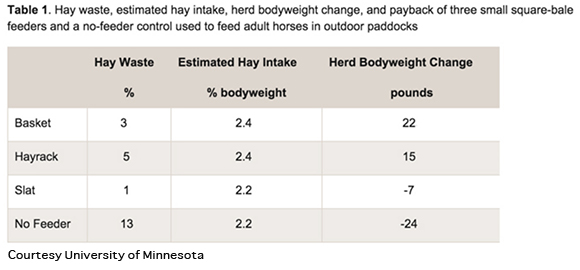
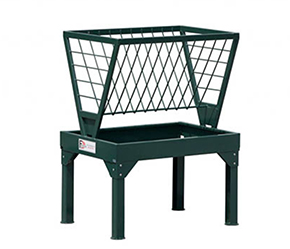 With clear evidence hay wastage is significantly reduced (30-40%) by the use of an outdoor hay feeder and additional research that was also included in the study that detailed horses ate at a slower pace with slats included in the hay feeder design, the decision to invest in a hay container may be clear cut. There is another benefit to the use of the feeder, the time and labor it can save the horse caregiver as the hay feeder can be filled with more than one day’s supply of rations at a time.
With clear evidence hay wastage is significantly reduced (30-40%) by the use of an outdoor hay feeder and additional research that was also included in the study that detailed horses ate at a slower pace with slats included in the hay feeder design, the decision to invest in a hay container may be clear cut. There is another benefit to the use of the feeder, the time and labor it can save the horse caregiver as the hay feeder can be filled with more than one day’s supply of rations at a time.
Set up of the hay feeder is very straightforward as you can simply place it anywhere in the pasture that you like. There are a few things to consider before you go ahead.
Ideally place the horse hay feeder on level ground in a well-drained location. If you expect a high volume of traffic then preparation of a large pad of rolled stonedust over a gravel base, will prevent muddy mayhem of your paddock. Remember that if you don’t move the feeder around periodically, then the grass beneath it will die off.
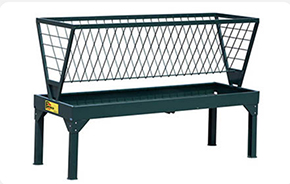 It may be wise to avoid placement close to fence lines, in case of arguments between horses at feeding time and the need for a horse lower in the pecking order to escape a bullying herd mate. Placement away from fence lines will also ensure an animal does not become trapped between the feeder and the fence.
It may be wise to avoid placement close to fence lines, in case of arguments between horses at feeding time and the need for a horse lower in the pecking order to escape a bullying herd mate. Placement away from fence lines will also ensure an animal does not become trapped between the feeder and the fence.
The feeder you purchase should be specifically designed for horses, as cattle feeders are often too low to be safe for horses and their design may contribute to a horse becoming entangled in the feeder and suffering serious injury as a result. Foals, ponies or other equus with small hooves and heads should be carefully monitored if a pasture hay feeder is utilized. Ideally, feeders should not be available to the inquisitive foal to protect it from damaging itself on the container. We have all seen the videos of horses standing in the center of an empty hay feeder, so keep your feeder full!
Remove string from all bales placed in the feeder to prevent accidental ingestion of twine by horses. I have seen horses caught up in loose uncut round bale twine left on the ground, that have resulted in serious rope type burns. It is also imperative to remove all halters, headcollars or cribbing collars from horses that have access to a hay feeder to prevent them becoming ensnared on the unit.
When making your choice of feeder, consider not just the type of bale you feed, but also the size of your herd. All animals need to have access to the hay ration at the same time. Placement of two or three feeders in a field for a large herd is a good idea to minimize stress between pasture mates and maximize 24-hour availability of hay to all horses.
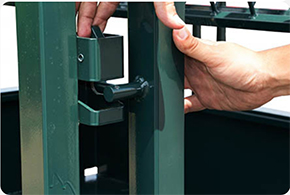 Make certain that the hay feeder you choose is sturdy and secure and will not be easily knocked over. The hardware for closing a gate on the hay feeder should be made of good quality hardware and be of such design that a horse may not ‘Houdini’ it open. If you have a concern that a horse may open the latch then secure a gate chain and gate clip. We’ve all had those mischievous horses.
Make certain that the hay feeder you choose is sturdy and secure and will not be easily knocked over. The hardware for closing a gate on the hay feeder should be made of good quality hardware and be of such design that a horse may not ‘Houdini’ it open. If you have a concern that a horse may open the latch then secure a gate chain and gate clip. We’ve all had those mischievous horses.
For any questions you may have concerning hay feeders offered at Horizon Structures, please don’t hesitate to give their friendly staff a call at 888-447-4337 and visit their website.
